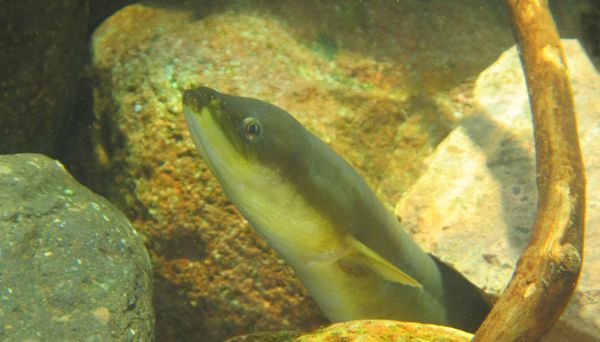Expertise
The European eel – mysterious and threatened
Reinhold Hanel | 01.12.2021
The European eel is acutely threatened. So far it has not been possible to take effective protective measures. The International Council for the Exploration of the Sea (ICES) has now, for the first time, clearly recommended a complete closure of eel fisheries in the entire distribution area.
Experts have been sounding the alarm for a long time, but so far, no action has been taken to effectively protect the European eel (Anguilla anguilla). This migratory fish, which lives and grows in North African and European waters before making a 5,000 to 7,000 km journey across the Atlantic Ocean to reproduce and spawn in the Sargasso Sea, is critically endangered. Since the early 1980s, the number of juveniles, called glass eels, has decreased dramatically. In the North Sea area, not even 1% of the numbers compared to that of the 1960s and 1970s is reached.
With its catch recommendations for 2022, the International Council for the Exploration of the Sea (ICES) has for the first time clearly spoken out in favor of a complete closure of eel fisheries in the entire range; this explicitly includes glass eel fisheries for eel aquaculture and restocking – i.e. the transfer of caught juvenile fish into lakes and rivers. To really protect the population of this endangered fish species, it is essential to fully implement this recommendation.
This applies not only to commercial fishing, but also to recreational fishing, because according to estimates, anglers and other recreational fishers in Germany catch about the same amount of eel as commercial fishers. If a complete closure of the eel fishery is not politically enforceable, it would at least be necessary to extend the existing three-month fishery ban in coastal waters to inland waters and to extend it, so that at least the silver eels migrating to their spawning area are protected. Anglers, who often see themselves as water wardens and nature conservationists, should generally refrain from catching eels until the stock has significantly recovered.
Also, the restocking of eels into inland waters to increase local stocks should be viewed critically, because the young eels used for stocking origin from wild catches and breeding eels in aquaculture is still not possible. In Germany in particular, young eels are still stocked into heavily fished and polluted waters and waters used for eel restocking have not yet been prioritized with regard to their value for rebuilding the stock. A significant proportion of restocked eels is released upstream of hydroelectric power plants, often even upstream of power plant chains, which significantly increases the mortality of eels in turbines. For the most part, eel restocking serves more to maintain a fishery than to rebuild a threatened stock.
A potpourri of factors
However, it is by no means only fishing that is responsible for the decline in eel stocks. River barriers as well as hydroelectric power plants and other transversal structures that make the natural migration of eel more difficult or impossible and deny access to important habitats have made a significant contribution to this. In addition, the pollution of water bodies presumably leads to an impaired reproductive capacity. The parasite infestation with a swim bladder worm imported from Asia could also be partly responsible for the decline in the population. The importance of each of these factors cannot be quantified, but the eel does not seem to be able to cope with the sum of these pressures.
The Thünen Institute for Fishery Ecology conducts research on all life stages of the European eel in order to identify changes in stock development and to contribute to a better understanding of the causes of stock decline. Investigations of early life stages in the spawning area in the Sargasso Sea and shortly before the transformation of the willow leaf-shaped larvae into glass eels along the European coasts are just as important as the quantitative assessment of silver eel migration from the large rivers of northern Germany, as done for example in the BALANCE research project. In addition, as part of a long-term DCF monitoring, we assess water-specific growth rates of eels in all river basins in Germany, as well as their contaminant load and parasite infestations.
As important as it is to understand the causes of the stock decline as completely as possible and to initiate long-term habitat improvements, it is also clear that in order to counteract a further decline of this highly endangered species, the short-term closure of commercial and recreational fisheries is the quickest way to achieve effects. Politically, however, this is not easy: While the marine waters are the responsibility of the EU within the framework of the common fisheries policy, inland fisheries are a matter for the federal states. So many actors are involved. It therefore remains interesting to see whether there will be an agreement on a comprehensive protection of this endangered species.







